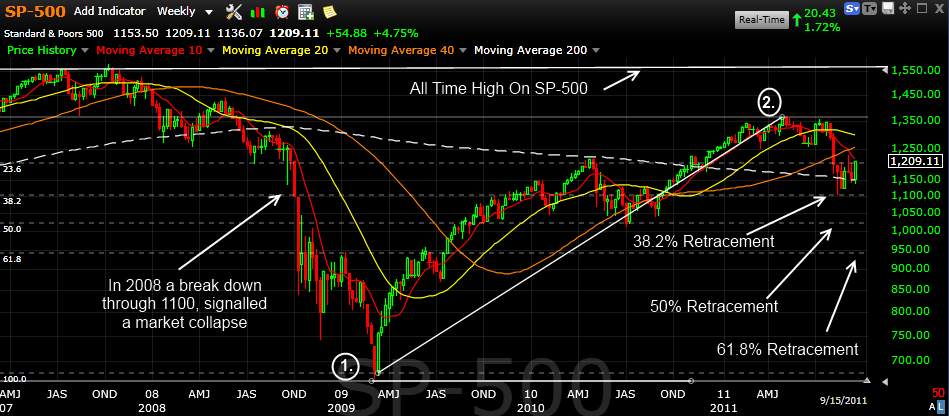The Fibonacci sequence is a series of numbers that describe the natural world and are used in technical analysis to plot stock chart patterns.
Italian mathematician Leonardo Pisano Fibonacci (1170-1250) introduced the Fibonacci sequence to the Western world, and financial traders adopted his work in the late 19th century.
This lesson covers Fibonacci in stock trading and the strategies you can use.

What is Fibonacci in trading?
Fibonacci trading involves using sequences to predict stock prices. Fibonacci sequences are a series of numbers, each the sum of the previous two. This can be used to predict stock support and resistance levels.
Why use Fibonacci sequences in trading?
Traders often use Fibonacci sequences to predict stock prices because they can be applied to any time frame. This means that they can be used for long-term or short-term trading. Fibonacci sequences can also be used to predict price patterns, which can be used to make trading decisions.
This lesson has been updated at this location.
What are the benefits of using Fibonacci sequences in trading?
Fibonacci sequences can be used to try to predict stock prices, which can help you make better trading decisions. Fibonacci sequences can also help estimate price patterns, giving you an edge in the market.
What are the risks of using Fibonacci sequences in trading?
If you use Fibonacci sequences in trading, you may find that your predictions are not always accurate. This can lead to losing money in the market. It would be best if you only used Fibonacci sequences as a guide and not as a replacement for your research.
What are Fibonacci levels?
The stock trading Fibonacci levels are numbers that predict stocks’ support and resistance levels. The Fibonacci sequence is created by adding the previous two numbers together.
The Fibonacci sequence is the sum of any two numbers that equals the next in the sequence.
0,1,1,2,3,5,8,13
0+1=1, 1+1=2, 1+2=3, 2+3=5, 3+5=8, 8+5=13
What is Fibonacci retracement?
Fibonacci levels for retracement are typically used to identify where the stock has stopped increasing and then use the Fibonacci sequence to predict how far it will decline from that point. The Fibonacci levels for retracement can draw a line from the peak of the stock price to the trough and then use the Fibonacci sequence to predict how far the stock will rebound.
Fibonacci Video Explainer
What are the Fibonacci retracement levels?
The most common Fibonacci retracement levels are 23.6%, 38.2%, 50%, and 61.8%. Traders often use these levels to help them decide where to enter and exit a trade. For example, a swing trader may buy a stock when it reaches the 23.6% Fibonacci retracement level after falling from a recent high.
The swing trader may sell the stock when it reaches the 38.2% or 50% Fibonacci retracement level.
The theory behind Fibonacci is that this mathematical pattern can be used to predict the waves of a trend.
The most critical Fibonacci retracement levels are in percentage terms:
23.6%, 38.2%, 50%, 61.8%
Therefore, if a stock price moves from $1 to 100$, it may retrace (go back down) to 1 of 4 important levels.
$23.60, $38.20, $50, $61.80
The Fibonacci sequence can attempt to predict the support and resistance levels for stocks by using a stock chart indicator to map the Fibonacci levels.
How to use Fibonacci sequences in trading?
To use Fibonacci sequences in trading, you must identify the Fibonacci sequence for the stock you are interested in. You can then use this sequence to predict support and resistance levels. Most stock charting software available today includes multiple Fibonacci indicators to help traders.
How Fibonacci Works in stock trading
In stock trading, we use Fibonacci sequences by plotting the indicator on a chart and using the retracement or extension lines to guide potential price targets or pivot points.
Fibonacci in Stock Trading Example: Covid Crash (2020 -2022)
In this example, we analyze the 2020 and 2022 stock market crashes.
5 Steps to Plot Your Fibonacci Levels
Click on the image above to open Tradingview
- Select the Fibonacci Retracement Indicator
- Select the lowest part of the price trend
- Click the top of the trend
- Observe the Fibonacci levels are automatically plotted for you
- See how price patterns fit neatly into the Fibonacci levels and where the possible downside price targets are.
Fibonacci in Stock Trading Example: Global Credit Crisis (2007 – 2012)

This weekly chart stretches from 2007 to 2012, and we have plotted Fibonacci retracement lines on the recovery trend. Follow the instructions below to try it for yourself.
You can use Fibonacci Retracement on any chart by following these instructions.
- Select the Fibonacci Retracement Tool in your charting package
- Select the lowest point on the chart; in this case, Point 1
- Drag your mouse to the highest point on the chart in the future; in this case, Point 2
You should then see the significant Retracement levels are drawn (the Grey Dotted Lines)
Important Points in the Chart
In the 4.5 years from 2007, the markets failed to reach an all-time high of 1,550.
The market collapsed in 2008 when it broke down through the 1,100-point level.
The Downside Price Target
- The retracement line at 38.2% equals 1,125 points in the index. This is currently a support line.
- Any drop through this area could see a further decline to 1,000 points, the 50% retracement line.
- The next drop zone could be 950 points, the 61.8% retracement line, which perfectly maps back to 2009 /2009.
The Upside Price Target
The 21.6% retracement line at circa 1,225 provided resistance. A strong move up through this area would be positive.
Fibonacci uses nature’s numbers to estimate potential areas for support and resistance in a stock’s chart pattern. Drawing from the bottom of an uptrend to the top of the uptrend helps you visualize where a stock may pull back while still in its uptrend. Conversely, using the Fibonacci indicator from the top to the bottom of a trend can allow us to visualize which price a stock might move upwards.
What are the important Fibonacci trading strategies?
Several Fibonacci trading strategies can be used to predict stock prices. One strategy is to use Fibonacci retracement levels. This involves identifying where the stock has stopped declining and then using the Fibonacci sequence to predict how far it will decline. Another strategy is to use Fibonacci fan lines. This involves drawing a line from the peak of the stock price to the trough and then using the Fibonacci sequence to predict how far the stock will rebound.
What are some tips for trading with Fibonacci?
When trading with Fibonacci, it is important to remember that the sequence’s predictions are not always accurate; like sequences in nature, these numbers and patterns commonly occur but are not always perfect.
It is also important to use stop-loss orders when trading with Fibonacci so you do not lose more money than you can afford.
What are the Fibonacci extension levels?
The Fibonacci extension levels are 23.6%, 38.2%, 50%, and 61.8%. These levels are used to identify where the stock has stopped falling, and then the Fibonacci sequence is used to predict how far it will rally from that point. The Fibonacci levels for an extension can be used to draw a line from the stock price’s trough to the previous peak and then use the Fibonacci sequence to predict how far the stock will rebound.
Using a Fibonacci fan trading strategy
A Fibonacci fan trading strategy is similar to using Fibonacci retracement levels, but it incorporates not just asset prices but time. Fibonacci fan trading involves drawing a line from the high to the low of a recent price move.
Once this line is drawn, horizontal and vertical lines are plotted at the 23.6%, 38.2%, 50%, and 61.8% Fibonacci levels. Additionally, a fan or arc is drawn on the chart.
These horizontal lines are called Fibonacci fans. Fibonacci fans can be used to predict where the stock is likely to find support or resistance. For example, a Fibonacci fan trading strategy may involve buying a stock when it reaches the 23.6% Fibonacci fan line after falling from a recent high. The trader may sell the stock when it reaches the 38.2% or 50% Fibonacci fan line.
Fibonacci trading strategy in stocks
Fibonacci trading is a type of trading that uses Fibonacci sequences and ratios to predict support and resistance levels. Fibonacci trading is based on the idea that stocks tend to move in cycles and that these cycles can be predicted using the Fibonacci ratios.
Traders use Fibonacci trading strategies to identify when a stock is likely to reverse direction. For example, a Fibonacci trading strategy may involve buying a stock when it reaches the 61.8% Fibonacci retracement level after falling from a recent high. The trader may sell the stock when it reaches the 38.2% Fibonacci retracement level.
Types of FibonacciIndicatorss
There are a few different types of Fibonacci indicators that traders can use. The three most common Fibonacci indicators are Fibonacci retracement levels, Fibonacci fans, and Fibonacci arcs.
Fibonacci retracement
Fibonacci retracement levels are horizontal lines drawn on a stock chart at certain percentages. These percentages are based on the Fibonacci sequence, a series of numbers where each number is the sum of the previous two. The most common Fibonacci retracement levels are 23.6%, 38.2%, 50%, and 61.8%.
Fibonacci fans
Fibonacci fans are similar to Fibonacci retracement levels but use a different pattern. A Fibonacci fan is created by drawing a line from the high to the low of a recent price move. Once this line is drawn, horizontal lines are drawn at the 23.6%, 38.2%, 50%, and 61.8% Fibonacci levels.
Fibonacci arcs
Fibonacci arcs are created by drawing a line from the high to the low of a recent price move and then drawing two arcs, one above and one below the stock price. The point where the two arcs intersect is the Fibonacci arc level. The most common Fibonacci arc levels are 38.2%, 50%, and 61.8%.
An Example of Fibonacci Arcs
Best Fibonacci trading software
Our research shows that TradingView, TrendSpider, and MetaStock have the best selection of indicators for trading Fibonacci strategies. All three charting tools have an excellent selection of Fibonacci indicators and tools.
See for yourself in our best stock trading software review.
Summary
In this section, we looked at charts and learned how to draw trend lines. Trendlines are a useful way to help us envisage support and resistance areas in a stock price. We then looked at chart patterns and what they mean.
We looked at all the major chart patterns. Then, we examined gaps in stock prices, the types of gaps, and how to act on them.
